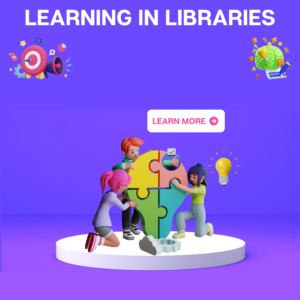
Throughout my career as an educator, I have loved examining and incorporating new trends and practices in my classroom (be it a middle school English classroom or my library). Some trends pass quickly, of course, while others have more staying power. But in the process of exploring and experimenting, my students and I have learned much about ourselves. The ideas of infinite learning and a library as a classroom have me feeling energized and excited about approaching my library as a dream classroom. I’ll include some inspirational highlights I found in the readings.
“Looking forward, I want these spaces and services to grow. I imagine libraries of the future as spaces for infinite learning. People will visit, both in person or virtually, and discover something new and outside-of-the-box to satisfy their curiosity,” (Stephens, 2014).
In Cleveland, librarians have made available kid-centered spaces that offer very different experiences: ArtLab and Studio 470 (Bookey, 2015). In the ArtLab, kids have the opportunity to create works anytime the library is open. The librarians rotate offerings, giving kids fresh opportunities. In Studio 470 kids have the chance to play different kinds of video games and use a rotation of maker technologies. I love that these libraries are making space for different ages and kiddos with different interests to experience. Also, video games are so popular with tweens and teens, but financially speaking they can be so out of reach for so many kids. This gives kids a chance to participate in popular culture that so many of them probably hear about at school, regardless of income. And with winter holidays coming soon, I can’t help but think of kids asking for consoles as gifts and the panic felt by families who can’t afford it. How nice it would be for families in my area to be able to feel less pressure if such a thing were available in libraries!
In the same article, I adored reading about outdoor-themed programs in Saint Paul Minnesota. (Bookey, 2015). In one case, kiddos can bring in items from nature that they can learn about, and they can also trade these items for other things from nature brought by other patrons. It’s such a sweet way to generate interest from kids who already tuned into nature. In the second case, kids can experience storytime while going for a walk outside. I love that the book is actually spread around the trail so anyone can stumble on it! These options bring me particular joy for a few reasons. First, I am continuously concerned about how much time kids (especially young kids) spend indoors, particularly with the way our education system is structured.
I enjoyed reading about librarians as teachers and collaboration partners, especially given my background as a classroom teacher and my current position as a school librarian (Lippincott, 2015). I love collaborating with teachers and enhancing their classes. I already see myself as a collaboration partner, but I like the way Lippincott fleshes this out in her article, including her justification for having technologies and spaces available in libraries. hey are generally one of the only places on campuses that serve all students, so it makes sense for libraries to offer such things for students and classes. Lippincott also has good advice for librarians at schools: learn about the classes and programs at your school so you can best support them, and help your students become, “…sophisticated content creators…,” (Lippincott, 2015).
I think it is easy for teachers and teacher-librarians to get bogged down in minutiae, paperwork, and projects, to perhaps feel trapped by “bureaucratic barriers” mentioned in The Heart of Librarianship (Stephens, 2016). I recently had a discussion with a friend who is a teacher at another institution, and it has been really sticking in the forefront of my mind, particularly while reading about creative classrooms and libraries. This teacher works at a massive public high school locally, and while he has been a passionate, creative teacher for many years, it becomes more and more challenging year after year when administrators and standardized testing chip away at one’s energy and enthusiasm. I feel very lucky to escape much of this in the library. In our library, I am free to explore and experiment as an educator in ways that it would be difficult for a classroom teacher to do. When considering educational opportunities for my kids, I don’t have to worry about testing or what the teachers in the next grade up will think when they get my kids (“Why don’t her kids know how to diagram sentences?!”). I have to consider budgets and reality, of course, but beyond that I simply have to consider what my kids need and how I can provide it for them. It’s a beautiful thing.
Resources
Bookey, J. L. (2015, April 29). 8 awesome ways libraries are making learning fun. HuffPost. https://www.huffpost.com/entry/8-awesome-ways-libraries_b_7157462
Lippincott, J. K. (2015, February 26). The future for teaching and learning: Librarians’ deepening involvement in pedagogy and curriculum. American Libraries. https://americanlibrariesmagazine.org/2015/02/26/the-future-for-teaching-and-learning/
Stephens, M. (2014) YLibrary? Making the case for the library as space for infinite learning [PDF file]. https://www.dropbox.com/s/p46kkmbkvwpdsng/YLibraryInfiniteLearning.pdf?dl=0
Stephens, M. (2016). The heart of librarianship. ALA Editions.
